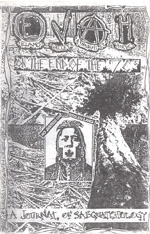The Archives
-
Books, Most Popular
Green Rage
12.03.12 | PermalinkGreen Rage: Radical environmentalism and the unmaking of civilization (1990, Boston, MA.)
One of the first books I bought about radical wilderness defense was Green Rage. It is an excellent investigation of the origins of (western) environmental radicalism, and I recommend that you read it cover to cover.
Speaking of covers, you might notice that this particular copy of Green Rage is a little ragged. The reason for that is because this is my copy, and after reading the book I took it’s message to heart. Several years ago in Oregon, a small group of activists from around the region were protesting at a breeding facility that supplied rabbits to the vivisection industry. When we arrived the farms owners were not present, and neither were any law enforcement. Not coincidentally I quickly found myself living with some critters who liked to chew on everything in our humble home. I hope you will enjoy Green Rage as much as they did!
…
-
One-off publications
Elaho Valley Anarchist Horde on the end of the 7Cs: A Journal of Sasquatchology
04.23.12 | PermalinkElaho Valley Anarchist Horde on the end of the 7Cs: A Journal of Sasquatchology (2001, Victoria, Canada)
“The sun shines brightly in the yard, the sky is clear, the air fresh and bracing. Now the last gate will be thrown open, and I shall be out of site of the guard, beyond the bars, – alone! How I have hungered for this hour, how often in the past years have I dreamed of this rapturous moment – to be alone, out in the open, away from the insolent eyes of my keepers! I’ll rush away from these walls and kneel on the warm sod, and kiss the soil, and embrace the trees, and with a song of joy give thanks to Nature for the blessings of sunshine and air.” Alexander Berkman, Prison Memoirs of an Anarchist.
Upon my own release from prison I traveled to Seattle from Sheridan, Oregon to turn myself in to a halfway house. I too was an anarchist in the hands of the enemy, and while my incarceration was not as long or harsh as Berkman’s, his memoir contains long portions – sometimes entire pages – that feel so familiar it seems as though I wrote them myself. Several times in the final chapter he mentions a longing for wilderness, an urge to run from the dead cities of the northeast into the forests. On that ride from one lockup to another I knew why. Civilization is inherently confining, and even outside of the greybar hotel most of our lives consist of moving from one box to another in a continuous and agonizing march that we have little power to control. Looking out the windows of my friends car I wanted the passing sprawl to be sucked into the soil and replaced with life, beauty, and liberty.
The nature of incarceration can certainly make a person think about the incarceration of nature, but even those anarchists who have been lucky or smart enough to stay out of state custody often get it. If you are opposed to the artificial hierarchies of class, why support the equally arbitrary hierarchies based on species? If you think that forests have less worth than humans than I say you haven’t met enough cops! There isn’t one authority figure on earth I wouldn’t trade for a tree, and anyone who would argue the opposite is a moron. But forgive my rambling, I have written all the above because this wonderful DIY zine has sparked my sense of rebellion and wildness!
The end of the 90s and the early 2000s was a busy time for forest defenders, and across the globe direct action campaigns for wilderness were abundant and inspiring. There are many famous examples, and while Warner Creek and the anti-roads campaigns of England may have stolen the spotlight, one rugged crew in British Columbia carried on an overlooked battle that every activist should know about. If you like raging warrior grannies, sabotage, unlikely coalitions, and open revolt against corporations and their governmental subsidiaries, then you ought to read up on the history of actions in the Elaho, Squamish, and Simms valleys. This zine, written by members of the Elaho Valley Anarchist Horde as both a primer for new activists coming to the Elaho and a means of publicizing the campaign, is an excellent introduction.






